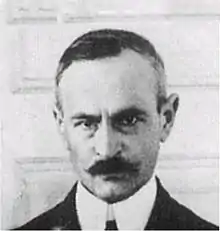Victor Henri
Victor Henri (6 June 1872 – 21 June 1940) was a French-Russian physical chemist and physiologist. He was born in Marseille as a son of Russian parents. He is known mainly as an early pioneer in enzyme kinetics.[2] He published over 500 papers in a variety of disciplines including biochemistry, physical chemistry, psychology and physiology.[1][3] Aleksey Krylov was his half-brother.
Victor Henri | |
|---|---|
 | |
| Born | 6 June 1872 |
| Died | 21 June 1940 (aged 68) |
| Citizenship | France |
| Scientific career | |
| Fields | Physical chemistry, physiology, physiological psychology[1] |
| Institutions | University of Paris, University of Göttingen, University of Leipzig, Université de Liège |
Life
Victor Henri's parents were Aleksandra Viktorovna Lyapunova and Nikolay Alexandrovich Krylov. They were not married. Instead, Krylov was married to the mother's sister, Sofiya Viktorovna. At that time, an illegitimate child had no rights if born in Russia, but if born in France would be a French citizen. Thus, his parents decided to travel to Marseilles. After Victor Henri was born there, Krylov and his legitimate wife adopted him, and took him back to Saint Petersburg. There he attended a German secondary school.
The two mothers were first cousins of Aleksandr Mikhailovich Lyapunov, a notable mathematician who did pioneering work in stability theory, Sergei Mikhailovich Lyapunov, a composer, and Boris Mikhailovich Lyapunov, who is well known in Russia as an expert in Slavic languages.
In 1891, Henri entered the Sorbonne University in Paris, where he received an education in mathematics and, later, in Natural Sciences. After finishing university, he got intrigued by philosophy and psychology.
Henri graduated with two PhD theses: in 1897 in psychology at the University of Göttingen and 1903 in Paris in physical chemistry.[4] In 1930, he was appointed full professor in physical chemistry at the University of Liège (Belgium).
Work
As several other researchers around 1900, Henri studied the invertase enzyme, which hydrolyzes sucrose into glucose and fructose, in order to derive a general rate law (kinetics) for enzymes.[5]
After the British scientist Adrian John Brown found that enzyme reactions were initiated by a bond between the enzyme and the substrate, and inspired by discussions with German physical chemist Max Bodenstein, he published, in 1902, for the first time the fundamental equation of enzyme kinetics.[4][6] He wrote it as follows:
where a and x denote the initial concentration of substrate and the concentration of product formed, respectively. The other symbols stand for constants. In modern notation, it can be written as
where , S and P denote the reaction velocity and the substrate and product concentrations, respectively. K1 and K2 stand for the dissociation constants of the enzyme-substrate-complex and enzyme–product complex, respectively.
It took about 10 years until the international community of biochemists realized the full significance of this equation. Notably, his work was taken up by German biochemist Leonor Michaelis and Canadian physician Maud Menten. They investigated invertase (saccharase) as well. In a seminal paper in 1913, Michaelis and Menten derived the equation in more detail and interpreted it more profoundly.[7] In particular, they interpreted the constants in the equation correctly and comprehensively. In particular, they recognized that considering the behaviour in the steady state at zero time with P = 0 would lead to simpler and more easily interpretable results, and thus paved the way for general applications.
In most cases, the equation is used for the special case P = 0 and is usually called Michaelis-Menten kinetics, sometimes Henri-Michaelis-Menten kinetics.[8] Deichmann et al. (2013) have suggested that the term Henri kinetics should be used for the above-mentioned equation (*) in which P > 0.[9]
Serge Nicolas wrote a comprehensive biographical article (in French) on Henri,[1] and a recent discussion of Henri's place in the history of enzyme kinetics, including an English translation of his thesis, is available .[10]
References
- Serge, Nicolas (1994). "Qui était Victor Henri (1872-1940)?". L'Année Psychologique. 94: 385–402.
- Srinivasan, Bharath (27 September 2020). "Words of advice: teaching enzyme kinetics". The FEBS Journal. doi:10.1111/febs.15537. ISSN 1742-464X.
- "Victor Henri". Whonamedit?. Retrieved 24 May 2011.
- Henri, Victor (1903). Lois Générales de l’Action des Diastases. Paris: Librairie Scientifique A. Hermann.
- V. Henri: Über das Gesetz der Wirkung des Invertins. Z. Phys. Chem. 39 (1901) 194–216
- V. Henri: Théorie générale de l’action de quelques diastases. C. R. Hebd. Séances Acad. Sci. 135 (1902) 916–919
- L. Michaelis & M.L. Menten: Die Kinetik der Invertinwirkung. Biochem. Z. 49 (1913) 333–369
- Z. Bajzer, E.E. Strehler: About and beyond the Henri-Michaelis-Menten rate equation for single-substrate enzyme kinetics. Biochem. Biophys. Res. Commun. 417 (2012) 982-985
- U. Deichmann, S. Schuster, J.-P. Mazat, A. Cornish-Bowden: Commemorating the 1913 Michaelis–Menten paper "Die Kinetik der Invertinwirkung": three perspectives. In: FEBS Journal. 2013, doi:10.1111/febs.12598
- Cornish-Bowden, A.; Mazat, J.-P.; Nicolas, S. (2014). "Victor Henri: 111 years of his equation". Biochimie. 107: 161–166. doi:10.1016/j.biochi.2014.09.018.